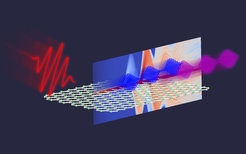High-energy photons from 2D materials
Scientists at the Max Planck Institute for Structure and Dynamics of Matter (MPSD) in Hamburg have demonstrated that two-dimensional materials can generate high-order harmonics with the same mechanism as atoms and molecules. This makes two-dimensional materials an attractive alternative to atoms and molecules for the generation of high-energy photons and ultrashort light pulses. Their work has been published in Science Advances.
The generation of high-order harmonics in gases is nowadays routinely used in many different areas of sciences, ranging from physics to chemistry and biology, to produce isolated attosecond pulses and coherent radiation, ranging from the visible to soft x-rays.
In this strong-field phenomenon, many low-energy photons emitted by a very strong laser are converted to fewer photons, but of higher energy. In crystals, the same mechanism exists, but the achievable photon energies are usually much lower than in atoms and molecules.

Using state-of-the-art theoretical simulation tools, scientists from the Max Planck Institute for the Structure and Dynamics of Matter (MPSD) in Hamburg showed that two-dimensional materials can behave like atoms and molecules, making these materials very attractive as possible new sources of light.
Atoms and molecules interacting with strong laser pulses emit high-order harmonics of the fundamental driving laser field. Because of a higher electronic density, crystals are one promising route towards compact, brighter HHG sources. However, at the present time, the maximum photon energy that can be obtained by HHG from crystals is considerably lower than in atoms.
Scientists from the MPSD’s theory department led by Angel Rubio have now shown that it is possible to use two-dimensional crystals as an alternative to atoms and molecules. Using extensive first-principles simulations, they researched how two-dimensional crystals react to a strong electric field polarized perpendicularly to the crystal.
The resulting electron dynamics are shown to be similar to the ones of atoms and molecules. In particular, the team showed that most of the strong-field electron dynamics are well explained by the semi-classical model iconic of HHG in atoms and molecules.
They also demonstrated how this model is modified in the case of two-dimensional crystals. Their results open a new avenue for the generation of high-energy photons and ultrashort light pulses in materials which offer more control possibilities than gases.












